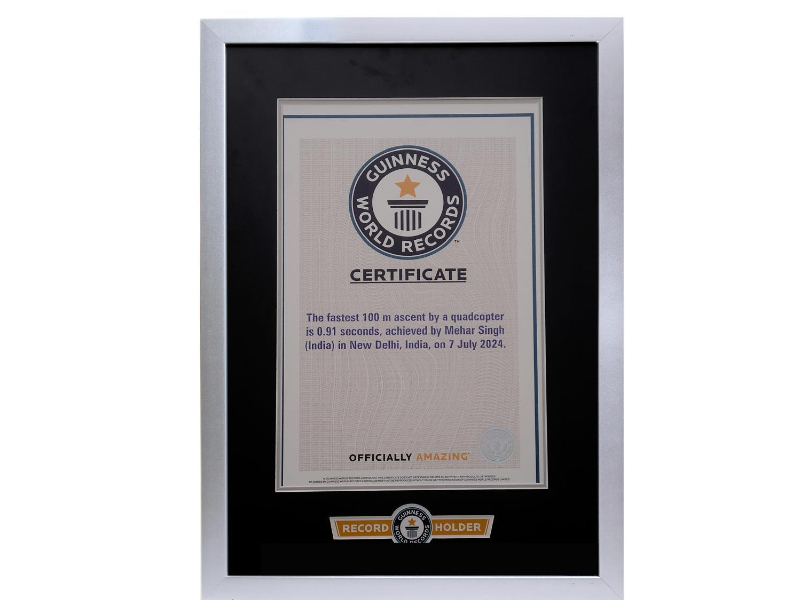At just 17, Mehar Singh has catapulted into the limelight, securing a Guinness World Record for the fastest 100-meter ascent by a quadcopter. His custom-built drone achieved this feat in an astounding 0.91 seconds, showcasing his exceptional technical skills and establishing a new standard in the rapidly evolving field of drone technology.

Mehar's path to this accomplishment was filled with challenges. His fascination with drones began in 8th grade, and his passion grew over the years. Driven by a desire to push technological boundaries, Mehar embarked on a months-long project to create a drone capable of unparalleled vertical acceleration.
"I've always been captivated by the idea of expanding the capabilities of drones," Mehar stated. "But breaking a world record wasn't just about the outcome; it was about the journey. I wanted to demonstrate that current technology could achieve something extraordinary, but the road to get there was fraught with obstacles."
The project involved Mehar designing, testing, and refining numerous drone prototypes. "There were times when I felt like I was pursuing an impossible dream," Mehar recalled. "I went through countless designs, and many failed during testing. Some drones crashed so badly that I had to return to the drawing board and start over. Each crash was a setback, but it also sparked new ideas and innovations."
Unfazed by the setbacks, Mehar dedicated himself to creating a drone that was not only fast but also aerodynamically optimized. "I spent countless hours on CAD software, meticulously designing and tweaking each component. The goal was to make the drone as streamlined as possible, which led me to shape it like a rocket. This design wasn't just about aesthetics; it was about reducing drag and maximizing speed."

Mehar's dedication to his craft paid off handsomely. "Every failure taught me something valuable," he said. "It forced me to think creatively and to consider every detail, from the materials used to the weight distribution of the drone. The process was grueling, but it was also incredibly rewarding to see my ideas take flight—literally."
This record-breaking achievement has significant implications for the future of drone technology. "The possibilities are endless," Mehar reflected. "High-speed vertical acceleration could revolutionize everything from emergency response to space exploration. This isn’t just about setting a record; it’s about opening doors to new innovations and applications."

Mehar’s work has already begun to inspire others. “I hope this accomplishment encourages other young innovators to push their own boundaries,” he said. “Technology is advancing rapidly, and there’s so much potential waiting to be unlocked. I’m excited to see where we can go from here.”
As Mehar looks ahead, his potential seems limitless. With his record-breaking drone, he has not only made history but also paved the way for future advancements in drone technology, marking just the beginning of his journey into the future of flight.
Newer articles
Older articles
 India Enters New Space Age as Astronaut Shukla Joins ISS Mission
India Enters New Space Age as Astronaut Shukla Joins ISS Mission
 X Cracks Down: Half a Million Indian Accounts Suspended for Policy Breaches
X Cracks Down: Half a Million Indian Accounts Suspended for Policy Breaches
 Google Unveils Strategy to Combat Misinformation, Boost Voter Access in India's 2024 Elections
Google Unveils Strategy to Combat Misinformation, Boost Voter Access in India's 2024 Elections
 Hair Oil vs. Hair Serum: Which is the Right Choice for Your Hair?
Alternatively:
Unlock Your Best Hair: Choosing Between Hair Oil and Serum for a Healthy Mane
Hair Oil vs. Hair Serum: Which is the Right Choice for Your Hair?
Alternatively:
Unlock Your Best Hair: Choosing Between Hair Oil and Serum for a Healthy Mane
 Bollywood's 'Swades' Anthem Joins Axiom-4 Mission: Indian Astronaut's Playlist Honors Heritage in Space
Bollywood's 'Swades' Anthem Joins Axiom-4 Mission: Indian Astronaut's Playlist Honors Heritage in Space
 Vijay Sethupathi Apologizes Amid Controversy Over Son's Film 'Phoenix'
Vijay Sethupathi Apologizes Amid Controversy Over Son's Film 'Phoenix'
 New York Assemblyman Zohran Mamdani's Style: 5 Lessons in Authenticity and Heritage
New York Assemblyman Zohran Mamdani's Style: 5 Lessons in Authenticity and Heritage
 Colon Cancer: Don't Ignore These 5 Early Warning Signs
Colon Cancer: Don't Ignore These 5 Early Warning Signs
 TSMC Regains Top 10 Global Value Ranking Amid AI Boom
TSMC Regains Top 10 Global Value Ranking Amid AI Boom
 Android Users Urged to Update Devices Amid High-Severity Security Flaws: Government Issues Warning
Android Users Urged to Update Devices Amid High-Severity Security Flaws: Government Issues Warning